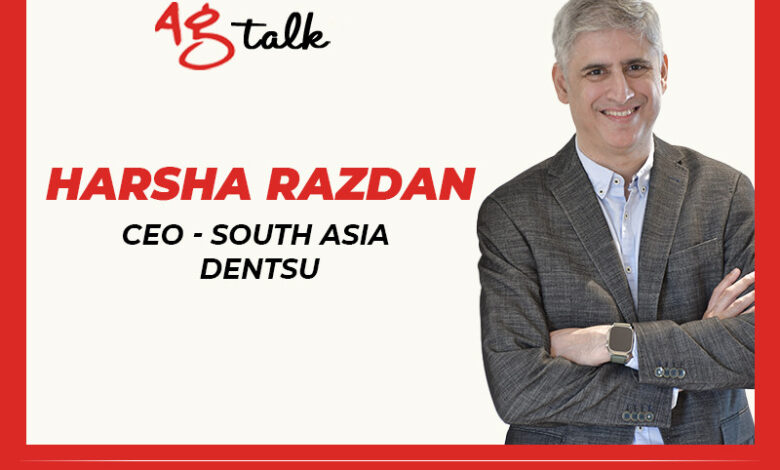Harsha Razdan’s transformative decisions, client-focused approach, and growth vision

Harsha Razdan took charge as CEO of South Asia at Dentsu almost six months ago, with a primary focus on bringing stability to the team. In this freewheeling chat with Adgully, Razdan says that his key priorities include realigning focus on clients, understanding the talent within Dentsu, and leveraging existing strengths for future success. One significant decision was the introduction of a ‘Net Promoter Score’ (NPS) to measure client satisfaction and foster a client-oriented mindset. Razdan emphasises on the importance of a client-focused mindset and the need to expand feedback beyond external clients to internal clients as well. He positions the company at the crossroads of marketing and technology, aiming to achieve 50% of revenue from Customer Experience (CX) by 2026. Regarding Dentsu India’s performance, Razdan mentions setbacks, but notes significant gains in the media and creative space. He outlines plans to strengthen current services, while expanding into new domains for a more comprehensive portfolio. Excerpts from the interview:
It’s been almost six months since you took charge as CEO of South Asia, Dentsu. What have been the key developments during this period and what were your major decisions in this period?
My primary focus at Dentsu was to bring stability and address leadership gaps. My initial goal was to convey that I’m here to listen and address concerns. The second priority involved realigning our focus on clients to overcome diverse internal perceptions. The third task was understanding and leveraging our existing talent for future endeavours.
A significant decision I made was to instill a client-oriented mindset within Dentsu by introducing the ‘Net Promoter Score’ (NPS). This score, ranging from one to ten, provides valuable insights into client perceptions. By collecting and analyzing NPS across various clients, we gain a comprehensive view. This shift towards a client-focused approach has been a key strategic move.
To expand client feedback, I introduced a broader set of clients for NPS evaluation. Emphasising this score as a critical self-evaluation metric, the goal was to gauge performance based on client feedback, both internal and external. The NPS served as a leading indicator of our company’s trajectory.
This approach uncovered instances where internal functions received low scores, prompting a re-evaluation of strategies to align efforts with actual business impact. I extended the use of metrics to various business functions within our company, such as the creative and media teams. The goal was to instill a client-focused mindset across the organization and dispel the perception of perfection.
We are used to a different way of working as far as agency is concerned or even other metrics are concerned within the organisation. Did you find it difficult when you tried to impose these kinds of parameters for somebody’s evaluation and reach a common objective?
In the first one or two months, people struggled to understand my approach because there was a general sense that everyone was already doing a perfect job. However, as we engaged with individuals, they began to see the logic behind it. The idea was simple: in a teamwork scenario, mutual feedback is crucial. If I don’t rate you and you don’t rate me, despite feeling individually successful, our collaboration suffers. The metric had to be a collective, anonymous evaluation from the entire team to build trust. This became evident when individuals, who believed they were excelling within their teams, received lower scores from the entire company. This discrepancy prompted a realisation that there might be significant issues that needed addressing.
The metric I introduced wasn’t conventional, but people eventually realised its simplicity. It boiled down to one number and a brief phrase, and the goal was for that number to improve in each quarterly survey. The collected phrases were used to create a word cloud, highlighting the most prominent feedback themes. Our approach was to focus on addressing the issues that stood out the most in the word cloud, simplifying the feedback process and providing a clear direction for improvement based on the team’s and the company’s most significant concerns.
You have worked in advertising as well as on the agency side. What is the difference that you see? And what’s the culture that you’re trying to set? What is your vision to drive Dentsu’s growth in the next three to four years?
If I look at Dentsu’s global vision, it aims to position itself at the crossroads of marketing and technology. Delving deeper, this alignment makes sense because, at its core, Dentsu is a marketing company. As our global CEO emphasises, we are a people-centered transformation company, focusing not just on HR transformation, but also on understanding the mindset of both consumers and employees. Recognising and comprehending these aspects puts us in the prime position for effective marketing. However, the synergy of marketing and technology is crucial; marketing alone lacks the necessary foundation without the support and capabilities that technology provides.
As a company positioned at the intersection of marketing and technology, the solutions required to serve our clients go beyond traditional boundaries. Creativity remains a crucial component, and media is a significant tool, though not the sole one. Clients seek solutions for a variety of challenges, and while we can address some, there are others where our capabilities may fall short. To meet these diverse needs, there’s a strategic expansion beyond media and creative domains into, what I term, the “CX space”, with a vision centered on data commerce. This broader approach defines the framework for our growth, allowing us to offer comprehensive solutions that extend beyond conventional marketing and technology boundaries.
How do you view the overall growth in India’s advertising industry in H1 of 2023 with the tightening of budgets? What is your prognosis for Indian advertising in H2 of 2023? What are the most challenging factors that you see?
The first half of the year witnessed healthy double-digit growth, but the outlook for the second half is less optimistic, likely dipping into single digits. The primary factor behind this shift is the tight market conditions, exacerbated by drying funding for start-ups. With the specter of a global recession looming, companies are exercising extra caution to avoid miscalculations in their financial projections. This caution is resulting in an overall tightening of spending. Looking ahead to the end of the year and the beginning of the next, the situation is expected to remain relatively similar. While events like Diwali, the Cricket World Cup, IPL, and general elections may provide temporary spikes and stimulate spending, they are viewed as short-term boosts rather than sustainable drivers of growth.
While spending is expected to rise in October and November compared to September, the key focus should be on consistent month-on-month industry growth with occasional fluctuations. The hope is for a robust economic recovery, leveraging the positive impact of government initiatives gaining traction. Despite challenges, the resilience within the industry remains strong, with events like IPL providing occasional boosts rather than being the sole drivers of sustained growth.
What are the most challenging factors that you see going into 2024?
In today’s creative and media landscape, the ongoing challenge revolves around balancing costs and revenue. In the face of shrinking expenditures, the imperative is to enhance efficiency. We are exploring various avenues for efficiency improvements, with a keen focus on adopting technology, including AI. The goal is to integrate AI to the extent that 25% of the work for our clients is AI-led, emphasising the strategic role of technology in optimising processes and delivering value.
The primary focus is on embracing technology to enhance efficiency and provide optimal solutions to clients, while also addressing the significant challenge of safeguarding data intellectual property securely. Another major challenge is the quest to grow revenue, which isn’t expected to happen easily through our traditional services. We are more than just a creative and media agency; we are a comprehensive value chain company situated at the crossroads of marketing and technology. So, there’s a need to get into new domains, data commerce, websites, etc., which will help balance the portfolio and give a more wholesome solution to our clients.
Could you tell us about Dentsu India’s performance in H1 of 2023?
Despite a few setbacks, we’ve performed reasonably well, and the losses we incurred were compensated by significant gains in the media and creative space. The new additions have effectively filled the gaps.
I could have performed much better if I hadn’t lost the clients. But it’s all hypothetical thinking, looking back at the mirror. Moving forward, the focus is on strengthening our creative and media teams, reinforcing the core aspects of our business. Additionally, there’s a commitment to innovation by introducing a new approach with CX-oriented thinking, set to be implemented in the country.
What do you see as the major growth drivers for Dentsu this year?
As we approach the end of this year with just a month and a half remaining, looking ahead to the next 12 months, our strategy will be a blend of two key elements. First, we plan to refine and delve deeper into the media and creative aspects, focusing on efficiency, technology utilisation, and delivering enhanced value to our clients. This forms one aspect of our approach. The other significant aspect revolves around the Customer Experience (CX) domain, a pivotal focus for us. Globally, Dentsu Group President and CEO Hiroshi Igarashi has outlined a vision of achieving 50% of revenue from CX by 2030. Personally, I aspire to expedite this goal to be achieved by 2026.
Our strategy involves fortifying our current business, scaling up new ventures through both organic and inorganic means with the infusion of new talent. Additionally, we are actively encouraging our team members to transition into new and emerging areas of business. This dual approach aims to not only retain our talent but also build comprehensive and fulfilling career paths for our people.
Have you been able to cope with the losses? And what are the new acquisitions or new gains that you’ve had at Dentsu?
We’ve won Carlsberg, Aditya Birla Capital, Berger Paints, and Torque Pharmaceuticals. There are two more big wins coming in, including one in December. I wished we could have gone higher. But again, I don’t want to look at life from a single perspective. While media and creative are two very important services that we offer, these are not the only services we offer. So, while we will continue to strengthen our current services, we will also be expanding into a new set of services. This strategic move is aimed at building a more comprehensive and diverse portfolio.
Post the merging of capabilities of Sokrati and iProspect, how are you building on their collective synergies? Since both agencies continue to operate as separate entities, how do the business efficiencies work out?
The insights gained from Sokrati, particularly in terms of backend operations and our overall operational approach, have been invaluable. These practices are considered exemplary. Viewing it as a common engine, the collaboration allows us to leverage the strengths of both entities, as they are robust brands in their own right. While maintaining the distinct identities of both client and front offices, our intention is not to blend them but rather allow them to coexist and evolve independently. Each brand has its unique positioning, and our strategy involves enhancing efficiency and fostering continuous learning at the backend. This approach ensures that both brands have a solid and fortified foundation to stand on, contributing to their individual strengths and overall success.
There were quite a few exits at Dentsu India last year. How are you looking at strengthening your leadership team? Is it full right now, or do you think there’s still a talent gap?
In recent years, Dentsu underwent strategic departures as part of a larger plan, consolidating acquisitions between 2014 and 2019 to strengthen our creative and media presence. Despite this, client confusion arose from the multitude of companies pitching services. To address this, Dentsu adopted a three-service line structure – media, creative, and CXM – simplifying offerings. Each entity retains its CEO. Currently, our leadership appears stable, but future growth necessitates infusing external talent while nurturing internal potential. Priority lies in developing internal talent, addressing a perceived lack of exposure rather than intent.
In talent recruitment, attitude takes precedence over top-notch capability, considering the need for diverse skills within the system. The goal is to assemble a team of internal talent with the right attitude, a commitment to upskilling, and the drive to make things happen. Regarding external talent, a balanced approach is vital for learning. Dentsu has streamlined its internal structure, with India reporting directly to APAC, which, in turn, reports to Japan.
Efforts to bridge understanding between global leadership and local markets include a visit by Dentsu Group President and CEO Hiroshi Igarashi to India. The focus is on fostering connection and flexibility in adapting offerings to the Indian market.
Formerly operating as a house of brands with individual P&L reporting, Dentsu has shifted to a client-centered model. Consolidating P&L at the country level eliminates brand-centric problem-solving, emphasizing a unified approach to address client challenges and foster a more client-focused strategy.
In this highly dynamic tech landscape, what are CEOs and CMOs looking at in terms of building strategic partnerships? What kind of organic and inorganic growth are you looking at?
CEOs have emphasised the importance of actively listening and addressing their challenges. When they talk about listening, they’re referring to involvement beyond just responding to RFPs or specific approaches. As a CEO, the primary concern revolves around growing revenue profitably and sustainably. To achieve this, there might be five strategic initiatives, and the expectation is for meaningful participation across all of them. Engaging with a comprehensive breadth of services positions us favourably. While there is a transitional phase from our current state to our desired position, this shift is crucial for garnering client respect and setting ourselves apart. Therefore, our organisational structure needs to align with client needs, focusing on newer services to broaden our range of offerings. This strategic approach is integral to gaining client trust and differentiation in the market.
When you look back at 2023, what are your key observations of this industry, especially the tech and the media industry?
In my perspective, technology and media have converged seamlessly, making it challenging to differentiate between them. Observing our Diwali campaigns, the integration is evident, and the boundaries have become increasingly blurred. When confronted with the question of traditional media versus new media, I find it irrelevant because everything is converging into a unified domain. Reflecting on historical shifts, like the advent of modern trade and e-commerce, predictions were made about the disappearance of small players and traditional retail. However, such predictions didn’t materialise. Over time, equilibrium is found, much like water finding its level. While there may be pressures between the new and the old, it’s essential to recognise that what is considered new today will inevitably become old tomorrow. Each element goes through its lifecycle, and everyone experiences different phases in their journey.
Similarly, with the integration of technology and data into media, there is a need to become more proactive in customising deliveries for clients. The speed of delivery to clients or consumers must be accelerated to keep up with the evolving landscape.
Looking forward to 2024, what are the major expectations? How much of a prop-up would the upcoming Lok Sabha elections provide to the advertising industry? What are the challenges that you foresee and how can the industry gear up to address these challenges?
You answered the question yourself. I think it will be a good prop-up, thanks to IPL and the upcoming elections. And we need the prop-ups, to be honest.
Relying on temporary boosts is akin to a short-term solution. I envision sustained, consistent growth for the industry, progressing year on year and month on month. Prop-ups, while providing a temporary bonus, shouldn’t be the primary driver. Looking ahead to 2024, I anticipate ongoing cost pressures on the industry, necessitating adaptation to the evolving landscape of technology, data, and marketing interactions. Resistance to this changing dynamic will only amplify the pressure. Predictions for 2024 suggest a stronger economy in the second half, particularly after the elections settle. The return of start-up funding and increased confidence are expected to drive higher spending. Importantly, this spending won’t be limited to creative and media; there’s a significant surge projected in data tech commerce, a market that surpasses the size and scale of the creative and media market. Dentsu’s strategy aligns with capturing a larger share of this space, aiming for a balanced portfolio to meet clients’ comprehensive needs and provide more fulfilling careers for our team.
What are your plans for Dentsu in 2024?
We will strengthen our talent in existing domains to make them more tech-savvy. We will also bring in external talent in new domains. Priority number one for 2024 is strategic and calculated acquisitions that facilitate the adoption of new methodologies, allowing internal teams to upgrade their skills. The focus is on shaping the newer version of Dentsu in alignment with evolving industry trends. Simultaneously, client feedback remains integral. Continuous engagement with clients involves seeking their experiences and understanding whether the intended objectives are being met.
My focus is on fortifying our existing business, enhancing technological capabilities, expanding into new business ventures, and adopting a client-centric approach. Continuous feedback from clients is integral to refining our journey and ensuring it aligns with their expectations. The insights gained from CEO feedback have been valuable. Looking ahead to 2025, I anticipate a stronger trajectory, especially in the second half of 2024, when the narrative of our strategic initiatives becomes more concrete and solidifies.





